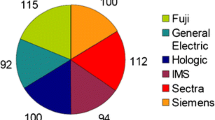Abstract
The aim of this work was to investigate the effect of mammographic acquisition parameter variations on the estimation of percent density (PD) produced by a particular semiautomated algorithm. The PD algorithm requires the user to specify a threshold pixel value segmenting breast tissue of greater and lesser density. A whole breast specimen was imaged using a variety of acquisition techniques, and the image data were processed as prescribed by the PD algorithm. PD estimates for all possible values of the user threshold were calculated for all the images. The image data were normalized so that PD varied between 30% and 80% over a fixed threshold range of 23, and a PD value of 50% was obtained for a threshold value of 195. PD differences between all the images and a baseline standard mammographic acquisition technique were calculated. We also estimated PD differences caused by small (3%) variations in operator selection of the threshold value. We found that the largest differences in PD involved changes in the density control of the mammography unit, and changes in the detector (either film type or computed radiography). The maximum PD differences due to technique were all less than 10%, with root-mean-square (RMS) variations less than 4%. PD differences due to operator variation were 24% (maximum) and 6.1% (RMS). These findings suggest that PD differences due to mammographic technique will be considerably less than those inherent to the technique, due to operator variation. All of these estimates are likely larger than differences seen in practice since optimization of the threshold by the operator was not considered in this analysis.
Similar content being viewed by others
References
Wolf JN, Saftlas AF, Salane M: Mammographic parenchymal patterns and quantitative evaluation of mammographic densities: A case-controlled study. Am J Roentgenol 148:1087–1092, 1987
Brisson J, Verrault R, Morrison A, et al: Diet, mammographic features of breast tissue and breast cancer risk. Am J Epidemiol 130:14–24, 1989
Saftlas AF, Hoover RN, Brinton LA, et al: Mammographic densities and risk of breast cancer. Cancer 67:2833–2838, 1991
Byng JW, Boyd NF, Fishell E, et al: The quantitative analysis of mammographic densities. Phys Med Biol 39:1629–1638, 1994
Boyd NF, Byng JW, Jong RA, et al: Quantitative classification of mammographic densities and breast cancer risk: Results from the Canadian National Breast Screening Study. J Natl Cancer Inst 87:670–675, 1995
Author information
Authors and Affiliations
Corresponding author
Rights and permissions
About this article
Cite this article
Hangiandreou, N.J., Mount, C.J., Brandt, K.R. et al. An investigation of the effects of mammographic acquisition parameters on a semiautomated quantitative measure of breast cancer risk. J Digit Imaging 13 (Suppl 1), 186–188 (2000). https://doi.org/10.1007/BF03167657
Issue Date:
DOI: https://doi.org/10.1007/BF03167657




